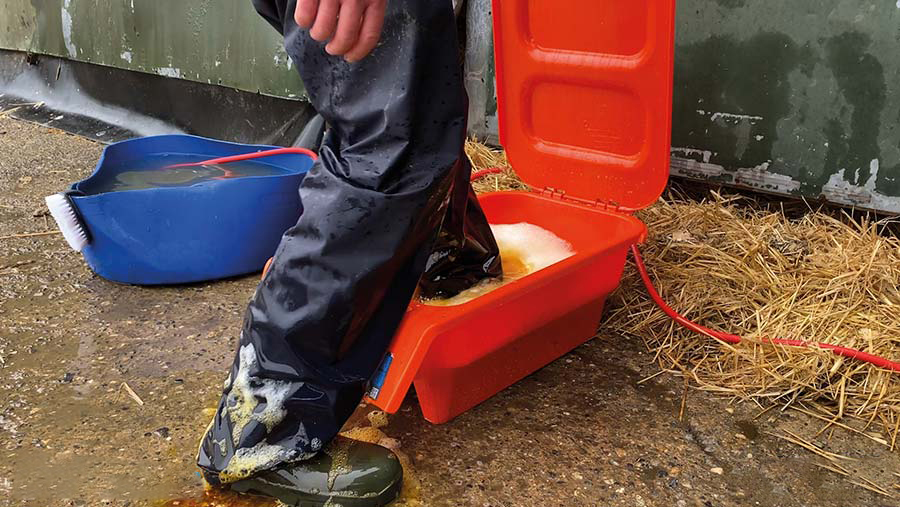4 tips to get staff to buy into farm biosecurity protocols
 © Progiene
© Progiene Only 31% of farmers follow biosecurity protocols, according to a survey of 100 UK dairy farmers by hygiene specialist Progiene.
The biggest reason biosecurity protocols were broken was lack of time, with 54% of respondents citing this as the main reason. A further 41% attributed it to a lack of understanding by staff.
Biosecurity is fundamental in helping to prevent the spread of disease and improve herd health and profitability, says veterinary consultant Tommy Heffernan.
See also: A guide to setting up a bovine TB isolation unit
“As our herds get larger, biosecurity is a bigger challenge on a lot of farms. But we can see a really good return when we look at the costs of some common diseases,” he explains.
Below, Dr Heffernan advises how dairy managers can get their staff to successfully adopt biosecurity protocols.
1. Carry out a farm audit
The first step is to carry out an audit, ideally alongside a vet, to provide “a helicopter view” of the farm and identify bottlenecks.
Each farm will have different challenges, but the review should cover these main areas:
- Disease monitoring
- Disease records
- Staff training
- Biosecurity response plan
- Bio-exclusion (external sources) such as boundaries, feed and slurry management, visitors, vehicles and foot-dip protocols, wildlife, and quarantine procedures
- Biocontainment (inside the herd) such as disease eradication strategies, sick animal management, housing and hygiene practices, internal disease risks and water quality and manure management.
It can be useful to code these green, yellow and red to identify areas that need immediate attention, what is already being done well and issues that can be worked on in the not-too-distant future.
Get the whole team involved and be honest about weaknesses. Concentrate on doing one or two things at a time so you don’t get overwhelmed.
2. Help staff understand why and set clear goals
The purpose of each biosecurity protocol should be outlined to staff, so they understand why the rules are important to follow in the first place.
A good way to get staff to buy into biosecurity protocols is to assign a member a specific area to research, help form a protocol and present back to the team.
It is also important to set clear, measurable goals so protocols can be reviewed.
It is really powerful to make an emotional or visible connection with staff to make them better understand the importance of adhering to biosecurity protocols. For example, using glitter on wellies can help show farm staff how easily diseases spread.
In hospitals, messaging was most effective when NHS staff were asked to wash their hands to “prevent the spread of infection to patients” rather than just “wash their hands”.
3. Create literature with clear guidelines and procedures
Each protocol should include clear guidelines so everyone who steps foot on the farm knows exactly what is expected of them.
Again, concentrate on one or two areas that require the most attention. If you struggle with milk quality, spend time putting together some standard operating procedures for this. Talk these through with staff and put a poster on the wall where every milker can clearly see it to act as a reminder.
Review protocols every three months to see how well they are working.
4. Hold team meetings
Farms are really busy places, so it is probably unrealistic to have team meetings on biosecurity every month. Instead, build them into the overall strategy.
Hold a weekly staff meeting to address key areas of focus for the week ahead and include an update on biosecurity. Ask what can be done better and how often boot dips have been changed.
These meetings are a good opportunity to recognise a member of staff who is doing something well, which helps build morale and a sense of pride.
Review biosecurity at least annually by revisiting your checklist.
Boot dips: ‘The first line of defence’
While 80% of farmers surveyed said they had a boot dip, 55% admitted they didn’t require every visitor to use it. Furthermore, 62% said they changed it less often than recommended.
“Boot dips are a small part of the biosecurity programme, but they are a huge part of the attitude and mindset towards biosecurity,” explains Dr Heffernan.
“It sends a clear message about how serious that farm is about hygiene and biosecurity. And it can prevent the spread of disease when done correctly.”
Dr Heffernan says all visitors should be asked to disinfect boots before stepping foot into the farmyard. He recommends:
- Minimising entry points on the farm
- Having a designated boot-dipping point
- Putting up clear signage of protocols on how to disinfect boots
- Providing a bucket and brush or water point for visitors to clean muck off their boots before they are dipped, as heavy soiling affects disinfection efficacy
- Replacing the foot-bath after 15 uses or, as a general rule of thumb, one litre of dip for each wash
- Using dipping internally to control spread at key points – for example, in youngstock areas.
For more information on correct foot-bath setup and use, watch Progiene’s BootDipper video.
Using disinfectants
Some 25% of farmers surveyed said they didn’t follow instructions when using disinfectants, with 15% admitting they never measured the volume of chemical used in boot dip.
Furthermore, 11% said they didn’t know if their disinfectant was Defra-approved.
It is essential to ensure disinfectants are approved by Defra to kill specific pathogens, says Alison Clark, dairy hygiene specialist for Progiene.
Quaternary ammonium compounds are forbidden on dairy farms because they contain residuals that stop the production of cheese, and chlorine is coming under more scrutiny, she adds.
“It’s important for farmers to check the product they are using,” she advises.
